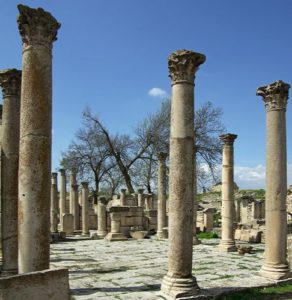Maktar is a large sprawling settlement with a lot of big new houses being built. Arriving from the west, we drove past the remains of the aqueduct bringing water to the town which has a few arches intact and a square mausoleum with a decorative carving standing in the middle of a bare rather scruffy area.
Macktaris is on a huge site on the outskirts of the town. It was a second century BC Numidian settlement that controlled the trade routes. After the fall of Carthage there was an influx of refugees as the town was outside the borders of Imperial Rome. It was later annexed by Rome and the Punic and Roman population coexisted peacefully. In the 2ndC AD the citizens were granted Roman citizenship and it became the richest town in the district. It was later fortified during the Byzantine times and finally destroyed in the 11thC.
There is a huge triumphal arch outside the town.
A new building houses the ticket office and a small museum which was closed when we visited. There are several carved tombstones erected outside it. Behind are the remains of the amphitheatre. This has double circular walls made of small stones with two large entrances opposite each other and smaller entrances between which would have given access to the seats which are no longer there.
A well made Roman road leads up to the main site. It has a paved surface with a large covered drain running down the centre. It is surrounded by stone walls. Trajan’s Arch dominates the forum area which is a large paved area with the remains of column bases. Behind Trajan’s arch are the remains of later Byzantine fortifications.
A series of buildings run down to the massive southern baths which were built at the peak of the town’s prosperity and are some of the best preserved in Tunisia. The walls still stand 10m high in places and they still have a lot of mosaics left in situ.
The Schola Juvenum is in a pleasant shady spot surrounded by trees. It still has a lot of standing columns and was the meeting place for well born youths to meet socially and learn to be good citizens. Next to it is what is described as a clover leaf quadrilobe building which has a series of small troughs . It has been suggested this could have been the treasury for the Schola. Beyond this set of buildings is a megalithic tomb.
Uphill from them are the remains of the northern baths with columns and arches. The site is difficult to decipher as part of it was converted into a church in the 5-6thC.
When we visited at the end of March the site was covered with orange marigolds and yellow ragwort and looked really attractive. There were a couple of women cutting the vegetation using hand sickles for animal feed.
Makthar is off the usual tourist beat and probably only visited by people travelling between Kairouan and El Kef. It could be done as a day trip from Kairouan. It gets few visitors and apart from the women cutting fodder and some people recording the mosaics in the southern baths we had the sight to ourselves. It is worth making the effort to visit if you enjoy Roman remains. The network of Roman roads around the site means that access for people with limited mobility is reasonable.








